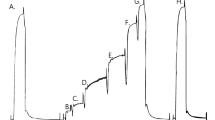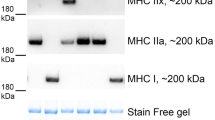Summary
Glycerinated rabbit psoas fibres have been modified with paramagnetic probes (IASL and MSL) which react selectively with the reactive sulphydryl on the myosin head. The extent of SH-1 modification was monitored by extracting myosin and measuring its ATPase activity in the presence of EDTA and of Ca2+. The isometric tension, stiffness, maximum velocity of contraction (slack test), and the force-velocity relation was measured as a function of the degree of SH-1 modification. Reaction of up to 50% of SH-1, i.e. 50% reduction in the K+-EDTA ATPase activity of extracted myosin, produced little change (<10%) in any of the fibre parameters. Modification of 75% of the SH-1 sites produced small decreases (15–30%) in the magnitude of all parameters, while reaction of more than 90% of SH-1 required long reaction times and produced decreases of 40–75%. In all cases the velocities of contraction decreased in parallel with the decrease in tension, while the decrease in stiffness was less pronounced. We conclude that a large fraction of muscle fibre SH-1 groups can be modified without greatly affecting the mechanical performance of the fibre. At least a portion of the decrease in fibre parameters that is observed at high levels of SH-1 modification can be attributed to modification of other sulphydryls by the probes. The reaction of both SH-1 and nonspecific sulphydryls abolishes myosin ATPase activity, and can account for approximately one half of the decrease in fibre parameters that is observed at high degrees of sulphydryl modification. We conclude that the modification of SH-1 does not greatly affect the function of a myosin head in the filament array of a fibre. This is in contrast to results obtainedin vitro where SH-1 modification alters several rates in the interaction of myosin with ATP and decreases the actin-activated ATPase activity of myosin subfragments.
Similar content being viewed by others
References
ARATA, T. & SHIMIZU, H. (1981) Spin label study of actin-myosin-nucleotide interactions in contracting glycerinated muscle fibers.J. molec. Biol. 151, 411–37.
BÁRÁNY, M., BÁRÁNY, K. & GAETJENS E. (1971) Change in the reactivity of the head part of myosin during contraction of frog muscle.J. biol. Chem. 246, 3241–9.
BÁRÁNY, M., GAETJENS, E., BÁRÁNY, K. & KARP, E. (1964) Comparative studies of rabbit cardiac and skeletal myosins.Archs. Biochem. Biophys. 106, 280–93.
BOREJDO, J. & PUTNAM, S. (1977) Polarization of fluorescence from single skinned glycerinated rabbit psoas fibers in rigor and relaxation.Biochim. biophys. Acta 459, 578–95.
BURKE, M. & REISLER, E. (1977) Effect of nucleotide binding on the proximity of the essential sulfhydryl groups of myosin. Chemical probing of movement of residues during conformational transitions.Biochemistry 16, 5559–63.
COOKE, R. & BIALEK, W. (1979) Contraction of glycerinated muscle fibers as a function of the ATP concentration.Biophys. J. 28, 241–58.
COOKE, R., CROWDER, M. S. & THOMAS, D. D. (1982) Orientation of spin labels attached to cross-bridges in contracting muscle fibres.Nature 300, 776–8.
COOKE, R. & FRANKS, K. E. (1978) Generation of force by single-headed myosin.J. molec. Biol. 120, 361–73.
CROWDER, M. S. & COOKE, R. (1983) The effect of myosin sulfhydryl modification on fiber tension, stiffness and velocity of contraction.Biophys. J. 41, 149a.
CROWDER, M. S., KWOK, M. & COOKE, R. (1983) Effects of salts on the reactivity of a fast reacting thiol of myosin in muscle fibers.Biophys. J. 41, 49a.
DUKE, J., TAKASHI, R., UE, K. & MORALES, M. F. (1976) Reciprocal reactivities of specific thiols when actin binds to myosin.Proc. natn. Acad. Sci. USA 73, 302–6.
EISENBERG, E., HILL, T. L. & CHEN, Y. (1980) Cross-bridge model of muscle contraction.Biophys. J. 29, 195–227.
HARRINGTON, W. F., REISLER, E. & BURKE, M. (1975) An activation mechanism for ATP cleavage in muscle.J. supramolec. Struct. 3, 112–4.
HUSZAR, G. & ELZINGA, M. (1971) Amino acid sequence around the single 3-methylhistidine residue in rabbit skeletal muscle myosin.Biochemistry 10, 229–93.
KIELLEY, W. W. & BRADLEY, L. B. (1956) The relationship between sulfhydryl groups and the activation of myosin adenosinetriphosphatase.J. biol. Chem. 218, 653–9.
KITAGAWA, S., YOSHIMURA, J. & TONOMURA, Y. (1961) On the active site of myosin A-Adenosine Triphosphate II. Properties of the trinitrophenyl enzyme and the enzyme free from divalent cations.J. biol. Chem. 236, 902–6.
KOMINZ, D. R., HOUGH, A., SYMONDS, P. & LAKI, K. (1954) The amino acid composition of actin, myosin, tropomyosin and the meromyosins.Archs Biochem. Biophys. 50, 148–59.
KUNZ, P. A., WALSER, J. T., WATTERSON, J. G. & SCHAUB, M. C. (1977) Isolation of cyanogen bromide and tryptic peptides containing the essential thiol groups from isolated myosin heads.FEBS Lett. 83, 137–40.
LIN, T.-I. & MORALES, M. F. (1977) Application of a one-step procedure for measuring inorganic phosphate in the presence of proteins: The actomyosin ATPase system.Analyt. Biochem. 77, 10–7.
MARTIN, J. B. & DOTY, P. M. (1949) Determination of inorganic phosphate. Modification of isobutyl alcohol procedure.Analyt. Chem. 21, 965–7.
MENDELSON, R., PUTNAM, S. & MORALES, M. (1975) Time-dependent fluorescence depolarization and lifetime studies of myosin subfragment-one in the presence of nucleotide and actin.J. supramol. Struct. 3, 162–8.
MULHERN, S. A. & EISENBERG, E. (1976) Further studies on the interaction of actin with heavy meromyosin and subfragment 1 in the presence of ATP.Biochemistry 15, 5702–8.
MULHERN, S. A. & EISENBERG, E. (1978) Interaction of spin-labeled and N-(Iodoacetyl-aminoethyl)-5-naphthylamine-1-sulfonic acid SH1-blocked heavy meromyosin and myosin with actin and adenosine triphosphate.Biochemistry 17, 4419–25.
MULHERN, S., EISENBERG, E. & KIELLEY, W. W. (1975) Interaction of actin with N-ethylmaleimide modified heavy meromyosin in the presence and absence of adenosine triphosphate.Biochemistry 14, 3863–8.
NIHEI, T., MENDELSON, R. A. & BOTTS, J. (1974) Use of fluorescence polarization to observe changes in attitude of S-1 moieties in muscles fibers.Biophys. J. 14, 236–42.
REISLER, E., BURKE, M. & HARRINGTON, W. F. (1974) Cooperative role of two sulfhydryl groups in myosin adenosine triphosphatase.Biochemistry 13, 2014–22.
SCHAUB, M. C., WATTERSON, J. G. & WASER, P. G. (1975) Radioactive labeling of specific thiol groups as influenced by ligand binding.Hoppe-Seyler's Z. Physiol. Chem. 356, 325–39.
SEIDEL, J. C. (1969) Similar effects on enzymic activity due to chemical modification of either of two sulfhydryl groups of myosin.Biochim. biolphys. Acta 180, 216–9.
SEIDEL, J. C. (1973) The effects of actin on the electron spin resonance of spin-labeled myosin.Archs Biochem. Biophys. 157, 588–96.
SEKINE, T., BARNETT, L. M. & KIELLEY, W. W. (1962) The active site of myosin adenosine triphosphatase. I. Localization of one of the sulfhydryl groups.J. biol. Chem. 237, 2769–72.
SEKINE, T. & KIELLEY, W. W. (1964) The enzymic properties of N-ethylmaleimide modified myosin.Biochim. biophys. Acta 81, 336–45.
SEKINE, T. & YAMAGUCHI, M. (1966) Superprecipitation of actomyosin reconstructed with F-actin and NEM-modified myosin.J. Biochem. 59, 195–6.
SILVERMAN, R., EISENBERG, E. & KIELLEY, W. W. (1972) Interaction of SH1-blocked HMM with actin and ATP.Nature New Biol. 240, 207–8.
SLEEP, J. A., TRYBUS, K. M., JOHNSON, K. A. & TAYLOR, E. W. (1981) Kinetic studies of normal and modified heavy meromyosin and subfragment-1.J. Musc. Res. Cell Motility 2, 373–99.
STONE, D. B. (1973) Interaction of actin with spin-labeled heavy meromyosin in the presence of nucleotides.Biochemistry 12, 3672–9.
THOMAS, D. D. & COOKE, R. (1980) Orientation of spin-labeled myosin heads in glycerinated muscle fibers.Biophys. J. 32, 891–905.
THOMAS, D. D., ISCHIWATA, S., SEIDEL, J. C., & GERGELY, J. (1980) Submillisecond rotational dynamics of spin-labeled myosin heads in myofibrils.Biophys. J. 32, 873–89.
TOKIWA, T. & MORALES, M. F. (1971) Independent and cooperative reactions of myosin heads with F-actin in the presence of adenosine triphospate.Biochemistry 10, 1722–7.
YAMAGUCHI, M. & SEKINE, T. (1966) Sulfhydryl groups involved in the active site of myosin A adenosine triphosphatase.J. Biochem. 59, 24–33.
Author information
Authors and Affiliations
Rights and permissions
About this article
Cite this article
Crowder, M.S., Cooke, R. The effect of myosin sulphydryl modification on the mechanics of fibre contraction. J Muscle Res Cell Motil 5, 131–146 (1984). https://doi.org/10.1007/BF00712152
Received:
Revised:
Issue Date:
DOI: https://doi.org/10.1007/BF00712152




